In a climate increasingly marred by relentless heatwaves, the surge in demand for air conditioners appears as an inevitable response. However, beneath the glossy veneer of affordability and advanced features lies a labyrinth of compromises. Consumers are often lured into a false sense of security, believing that a lower price point guarantees quality and durability. In the Indian context, many brands promote their latest models as the ultimate solution for comfort, but closer scrutiny reveals a maze of pitfalls. The so-called “best” window ACs in the under-Rs 30,000 bracket frequently sacrifice long-term reliability for short-term affordability. This shortsighted focus on initial cost blinds consumers to the hidden costs, potential inconveniences, and environmental impact of these units.
The narrative that cheaper ACs can deliver comparable performance to premium models is fundamentally flawed. Low-cost units often feature inferior components, less efficient compressors, and substandard refrigerants. Over time, these flaws manifest as increased electricity bills, frequent breakdowns, or complete failure. A consumer’s pursuit of immediate relief—bypassing critical evaluation—sets a dangerous precedent: buying cheap, replacing often, and contributing to a cycle of waste and environmental harm. It’s high time that buyers shift their perspective from transactional savings to investing in longevity, energy efficiency, and health.
The Market’s Deception: Overpromising, Underperforming
The marketing strategies employed by many brands prey on consumers’ desire for cooling comfort, yet seldom live up to the hype. Take the case of turbo modes, self-diagnosis features, or anti-corrosion coatings—these buzzwords often serve as marketing ploys rather than genuine performance enhancers. For example, “ultra silent operation” touted by some models is rarely truly silent, often merely quieter than older counterparts but still disruptive. Similarly, features like low gas diagnosis or auto-restart sound promising, but they frequently depend on manufacturer updates or maintenance routines that consumers neglect to perform or know how to interpret.
Furthermore, the so-called “durability” perks such as copper coils with anti-rust coatings are not immune to degradation over years of exposure to harsh Indian weather conditions. Many consumers, overwhelmed by technical jargon, fail to scrutinize whether these features translate into real-world benefits or are just marketing gimmicks. The promise of energy-efficient star ratings, like 3-star models, often does not match actual consumption, especially if the AC is poorly maintained or used suboptimally. While brands may highlight their advanced condenser coatings or filters, the true measure of these units lies in their long-term resilience—something that mass-market units rarely deliver.
Environmental Impact: A Cost Consumers Ignore
One of the most overlooked aspects of India’s burgeoning AC market is its environmental footprint. Cheap, non-inverter models with high energy consumption contribute significantly to carbon emissions and strain India’s fragile power grid, especially during peak summers. Many of these units run on non-inverter compressors, which cycle on and off repeatedly, wasting electricity and accelerating wear and tear. Additionally, the refrigerants used in low-cost units are often outdated and have high Global Warming Potential (GWP). Consumers may not realize that by choosing the least expensive model, they inadvertently contribute to climate change and environmental degradation.
The promise of affordable cooling must be tempered with awareness about sustainable consumption. Instead of blindly opting for the cheapest units, consumers should consider energy-efficient, inverter-based ACs that, despite higher upfront costs, significantly reduce monthly bills and environmental harm. Ignoring this is tantamount to neglecting the deeper responsibility we hold towards a planet teetering on the brink of crisis. The widespread belief that saving now equates to saving the environment is naive; true sustainability demands informed choices that prioritize eco-friendly technology.
The Need for Consumer Vigilance and Responsible Purchasing
In this chaotic market, the onus is on consumers to demand transparency and durability. Clear, honest information about the lifespan, efficiency, and environmental impact of these appliances is scarce. Instead, they are bombarded with flashy features and aggressive marketing, which obscure the reality that many units are merely temporary fixes masked as “smart” investments.
A responsible buyer must dig deeper—question the longevity of the components, scrutinize the brand’s reputation for after-sales service, and consider the total cost of ownership rather than initial price alone. Brands should be held accountable for delivering real value—nothing less. Meanwhile, consumers need to challenge the prevailing narrative that more features mean better quality. Often, simplicity, proper maintenance, and mindful usage trump overhyped bells and whistles.
Until there is greater awareness about these issues, India’s AC market will continue to be a playground for deceptive marketing and superficial fixes, rather than a platform for sustainable, healthy, and economically sensible cooling solutions.



Leave a Reply